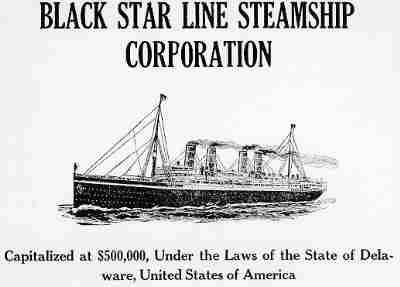Founder Marcus Garvey | Founded 1919 | |
 | ||
Black star line player piano music
The Black Star Line (1919−1922) was a shipping line incorporated by Marcus Garvey, the organizer of the Universal Negro Improvement Association (UNIA), and other members of the UNIA. The shipping line was created to facilitate the transportation of goods and eventually African Americans throughout the African global economy. It derived its name from the White Star Line, a line whose success Garvey felt he could duplicate. Black Star Line became a key part of Garvey's contribution to the Back-to-Africa movement. It was one among many businesses which the UNIA originated, such as the Universal Printing House, Negro Factories Corporation, and the widely distributed and highly successful Negro World weekly newspaper.
Contents
The Black Star Line and its successor, the Black Cross Navigation and Trading Company, operated between 1919 and 1922. It stands today as a major symbol for Garvey followers and African Americans in search of a way to get back to their homeland. It is not to be confused with the Black Star Line, the state shipping corporation of Ghana.
Marcus garvey unia black star line
History
The Black Star Line was incorporated as a Delaware corporation on June 27, 1919. Having a maximum capitalization of $500,000, BSL stocks were sold at UNIA conventions at five dollars each.
The first directors of the Black Star Line were Marcus Garvey, Edgar M. Grey, Richard E. Warner, George Tobias, Jeremiah Certain, Henrietta Vinton Davis, and Janie Jenkins. The officers of the corporation were President Marcus Garvey, First Vice President — Jeremiah Certain, Second Vice President Henrietta Vinton Davis, Treasurer George Tobias, Secretary Richard E. Warner, Assistant Secretary Edgar M. Grey and Assistant Treasurer Janie Jenkins. Six months after incorporation the Board of Directors voted to increase the Black Star Line market capitalization to $10,000,000.
The Black Star Line surprised all its critics when, only three months after being incorporated, the first of four ships, the SS Yarmouth was purchased with the intention of it being rechristened the SS Frederick Douglass. The Yarmouth was a coal boat during the First World War, and was in poor condition when purchased by the Black Star Line. Once reconditioned, the Yarmouth proceeded to sail for three years between the U.S. and the West Indies as the first Black Star Line ship with an all-black crew and a black captain. Later Joshua Cockburn, the captain of the Yarmouth, was accused of receiving a "kick back from the purchase price".
The SS Yarmouth was not the only ship to be purchased in poor condition and to be completely oversold. Garvey spent another $200,000 for more ships. One, the SS Shadyside, sailed the "cruise to nowhere" on the Hudson River one summer and sank the next fall because of a leak. Another was a steam yacht once owned by Henry Huttleston Rogers. Booker T. Washington had been an honored guest aboard the ship when it was owned by his friend and confidant, Rogers, and was known as the Kanawha. However, Rogers had died in 1909, and the once well-maintained yacht had also served in the first World War. After having been renamed the SS Antonio Maceo by the Black Star Line, it blew a boiler and killed a man.
Besides oversold and poorly conditioned ships, the Black Star Line was beset by mismanagement and infiltration by agents of J. Edgar Hoover's Bureau of Investigation (the forerunner to the Federal Bureau of Investigation), who − according to historian Winston James − sabotaged it by throwing foreign matter into the fuel, damaging the engines. On its first commission, the Yarmouth brought a shipment of whiskey from the U.S. to Cuba (before prohibition) in record time, but because it did not have docking arrangements in Havana, it lost money sitting in the docks while the longshoremen had a strike. A cargo-load of coconuts rotted in the hull of a ship on another voyage because Garvey insisted on having the ships make ceremonial stops at politically important ports.
In 1919, J. Edgar Hoover and the BOI charged Marcus Garvey and three other officers with mail fraud. The prosecution stated that the brochure of the Black Star Line contained a picture of a ship that the BSL did not own. The ship pictured was the Orion, which in the brochure was renamed the Phyllis Wheatley, and at the time was going to be bought by the BSL, but which they did not yet own. The fact that the ship was not owned yet by the BSL warranted mail fraud. "In 1922, Garvey and three other Black Star Line officials were indicted by the U.S. government for using the mails fraudulently to solicit stock for the recently defunct steamship line." The Jury only convicted Garvey, not the other three officers, and he was sentenced to five years in prison. In 1927, President Calvin Coolidge deported Garvey back to Jamaica.
The Black Star Line ceased sailing in February 1922. The company's losses were estimated to be between $630,000 and $1.25 million. It is regarded as a considerable accomplishment for African Americans of the time, despite mismanagement, engineers who overcharged, and the Bureau of Investigation's acts of infiltration and sabotage.
Impact
The flag of Ghana adopted a black star as an homage to this line.
